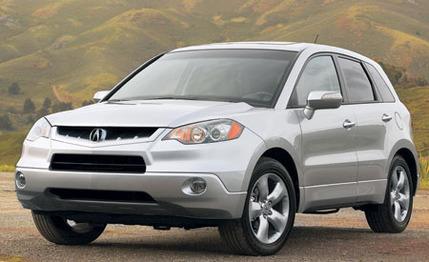
 First Drive Review
First Drive Review
Having pored over the socioeconomic star charts, interpreted tea leaves, studied chicken entrails, and otherwise peered into the future, Acura's marketing soothsayers foresaw a new and growing portal in the sales cosmos for a vehicle class they identify as "entry premium CUV" (Crossover Utility Vehicle). Fortified by this wisdom, the Acura product-development team created this vehicle to exploit the potential seam in the automotive firmament: the RDX, a "CUV" conceived to have plenty of "valet cachet" and also sufficient cargo space for the accouterments of 30-something professionals - Acura refers to them as "high-energy urbanites" living a "24/7 lifestyle." Acura's portrayal of a 24/7 urban lifestyle includes kayaks, mountain bikes, scuba gear, snowboards, and other bulky items. No problem. The rear seats fold flat - without removing the headrests - creating a 61-cubic-foot cargo hold.
As for the valet-cachet part, we have trouble seeing much of it here. Aside from its Acuraesque front end, the RDX looks pretty much like a lot of other SUVs scampering around out there - same arched roofline, same sloping liftgate. It's not a look that's likely to show up among the Ferraris in the valet front row at Mario Batali's new joint, Del Posto.
Speaking of looks, what the Acura RDX resembles a lot, particularly from the B-pillar forward, is its big brother, the MDX. However, that resemblance is familial rather than structural. Or dimensional. The RDX rides on a shorter (by 2.0 inches) 104.3-inch wheelbase, and at 180.7 inches long, 73.6 inches wide, and 65.2 inches tall, it is 8.0, 3.4, and 3.5 inches smaller, respectively, than the MDX. At just about 4000 pounds it's roughly 500 pounds lighter, it seats five rather than seven, and towing capacity tops out at 1500 pounds rather than 3500, on the theory that high-energy urbanites aren't likely to be fooling around with trailers.
What all this adds up to is a dedicated platform that shares nothing with the MDX. The platform is 95-percent all-new, according to Acura, destined to be shared with the Honda CR-V that's due this fall. What won't be shared is the RDX's engine, a 2.3-liter i-VTEC (intake side only) DOHC 16-valve four force-fed by a turbocharger inhaling through a top-mounted air-to-air intercooler. Acura says all-new about this, too, but aside from its smaller (by 1mm) bore and reduced compression (8.8:1 versus 10.5:1), this is strongly reminiscent of the 2.4-liter four that powers the Acura TSX.
Still, a turbo Honda is something new in the U.S. market. The rationale is simple. The product planners wanted V-6 performance and four-cylinder fuel economy. Nothing new about that, but as we've come to expect, Honda has put its own spin on the details. The turbo, developed jointly by Honda and Aisin, features variable flow capability, achieved via a valve in the exhaust manifold. At engine speeds below 2000 rpm, the valve slightly closes, which increases the velocity of the exhaust gas and makes the turbo spool up quicker. It's the same idea as putting a thumb over the end of a garden hose to rinse your car. At about 2000 rpm, the valve starts to open and is fully open by 2500 rpm.
The result is quick spool-up, and with or without using the paddle shifters, the RDX's five-speed automatic is equally ready to rock. With the turbo blowing at max boost (13.5 psi) and the engine generating max output (240 horsepower at 6000 rpm), the RDX should be capable of 0-to-60-mph times under eight seconds, comparable with the BMW X3. More on that in a minute.
The suspension setup entails struts up front, and the multilink rear embraces a simplified version of the SH-AWD system employed on the RL sedan. In normal operation, 90 percent of the power goes to the front wheels, but this can vary up to 70 percent to the rear. At the rear axle, the SH-AWD can send as much as 100 percent of available torque to one wheel, which Acura says improves handling by overdriving the outside rear wheel in a corner.
Delivered by a set of 235/55 all-season performance tires on 18-inch alloy wheels, grip seems plentiful, and the speed-sensitive variable-power-assist rack-and-pinion steering is quick (2.8 turns lock-to-lock) and reasonably informative. Acura lists weight distribution as 52 front/48 rear, but with its front-biased power delivery, the RDX behaves like a front-drive vehicle and understeer is its defining characteristic.
Although there's enough roll stiffness to encourage some back-road friskiness, the RDX's suspension tuning is a little more compliant than the X3's, which adds up to friendlier all-around ride quality. Friendlier also applies to the cabin, which feels posh compared with the stern interior of the X3. And of course there's a load of standard stuff baked into the RDX's base price: terrific heated leather front seats, a power sunroof, premium audio with XM-satellite-radio capability, a tilting-and-telescoping steering wheel, stability control, ABS, curtain airbags, tire-pressure monitoring - which only skims the top.
You've noticed we keep men-tioning the X3. That's because the X3 is Acura's marketing target. With a base price of $37,495, it probably represents an easy target, too. Acura was typically close-mouthed about pricing, saying the RDX would be "between $30,000 and $37,000" when it goes on sale this month. We're guessing a base price at the lower end of that range - say about $32,000. That would give the RDX a useful edge over its Bavarian target. But we wonder how it will fare against less-expensive and similarly powered newcomers, such as the Mazda CX-7. We'll have to wait and see.